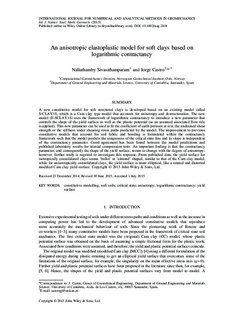| dc.description.abstract | A new constitutive model for soft structured clays is developed based on an existing model called S-CLAY1S, which is a Cam clay type model that accounts for anisotropy and destructuration. The new
model (E-SCLAY1S) uses the framework of logarithmic contractancy to introduce a new parameter that controls the shape of the yield surface as well as the plastic potential (as an assumed associated flow rule is applied). This new parameter can be used to fit the coefficient of earth pressure at rest, the undrained shear strength or the stiffness under shearing stress paths predicted by the model. The improvement to previous constitutive models that account for soil fabric and bonding is formulated within the contractancy framework such that the model predicts the uniqueness of the critical state line and its slope is independent of the contractancy parameter. Good agreement has been found between the model predictions and published laboratory results for triaxial compression tests. An important finding is that the contractancy parameter, and consequently the shape of the yield surface, seems to change with the degree of anisotropy; however, further study is required to investigate this response. From published data, the yield surface for isotropically consolidated clays seems ‘bullet’ or ‘almond’ shaped, similar to that of the Cam clay model; while for anisotropically consolidated clays, the yield surface is more elliptical, like a rotated and distorted modified Cam clay yield surface. | |
